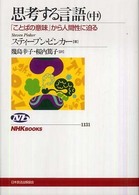- ホーム
- > 洋書
- > 英文書
- > Computer / General
Full Description
Simplify SharePoint with this comprehensive, understandableguide SharePoint is a Microsoft technology that enables projectcollaboration through a single portal. It can be complex, but notwhen approached the Dummies way! This guide offers eight self-contained minibooks that examineeach aspect of SharePoint 2010. Whether you're an experiencedadministrator or developer or you're just getting your feet wet,you'll find it's easy to locate what you need and learn to install,configure, and manage a SharePoint portal. You can dig as deeplyinto SharePoint as you want or need to.
* SharePoint 2010 is the newest version of collaborationtechnology that allows you to aggregate SharePoint sites,information, and applications into a single portal * Administrators, page producers, and developers will be able toget SharePoint installed, configured, and running with the advicein this guide * Eight minibooks address the Microsoft Office SharePoint system,SharePoint services, collaboration, SharePoint Server, enterprisecontent management, managing users, architecting SharePoint, andSharePoint deployment * Covers planning, installation, configuration, performance,troubleshooting, data structure, and more If you work with SharePoint, you'll find Microsoft SharePoint2010 All-in-One For Dummies provides what you need to getstarting and keep going with SharePoint 2010.
Contents
Introduction. Book I: Introduction to SharePoint. Chapter 1: Getting to Know SharePoint. Chapter 2: Introducing Microsoft SharePoint Foundation 2010. Chapter 3: Getting Started with a Basic Site. Chapter 4: Introducing SharePoint Server 2010. Chapter 5: Enterprise Content Management. Chapter 6: Offi ce 2010 and Offi ce Web Applications. Book II: Architecture and Planning. Chapter 1: The Framework. Chapter 2: Assessing Authentication Options. Chapter 3: Considering the Logical Architecture. Chapter 4: Designing the Logical Architecture. Chapter 5: Planning for Performance and Scalability. Chapter 6: Touring Central Administration. Chapter 7: Automating with PowerShell. Chapter 8: Using Service Applications. Book III: Services Configuration and Management. Chapter 1: Analyzing Access Services. Chapter 2: Burrowing into Business Connectivity Services. Chapter 3: Exploring Excel Services. Chapter 4: Investigating InfoPath Forms Services. Chapter 5: Maneuvering the Managed Metadata Service. Chapter 6: Submerging into Search. Chapter 7: User Profi les, Organization Profi les, andAudiences. Chapter 8: Considering PerformancePoint Services. Chapter 9: Considering Visio Services. Book IV: Using the SharePoint Services. Chapter 1: Publishing Access Applications. Chapter 2: Connecting to External Data. Chapter 3: Using External Content. Chapter 4: Working with Excel Services. Chapter 5: Investigating InfoPath Designer 2010. Chapter 6: Designing Browser Compatible Forms. Chapter 7: Examining the InfoPath Forms Services Tools. Chapter 8: Designing and Administering Search. Chapter 9: SharePoint Gets Social. Index.






